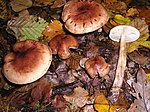
Matsutake, Tricholoma matsutake, is a species of choice edible mycorrhizal mushroom that grows in East Asia, northern Europe, and North America. It is prized in Japanese cuisine for its distinct spicy-aromatic odor.

Mushroom poisoning is poisoning resulting from the ingestion of mushrooms that contain toxic substances. Symptoms can vary from slight gastrointestinal discomfort to death in about 10 days. Mushroom toxins are secondary metabolites produced by the fungus.

Clitocybe nuda, commonly known as the blewit or wood blewit and alternately described as Lepista nuda, is an edible mushroom native to Europe and North America. Described by Pierre Bulliard in 1790, it was also known as Tricholoma nudum for many years. It is found in both coniferous and deciduous woodlands. It is a fairly distinctive mushroom that is widely eaten, though there is some caution about edibility. Nevertheless, it has been cultivated in Britain, the Netherlands and France.

Tricholoma equestre or Tricholoma flavovirens, commonly known as the man on horseback or yellow knight is a formerly widely eaten but arguably hazardous fungus of the genus Tricholoma that forms ectomycorrhiza with pine trees.
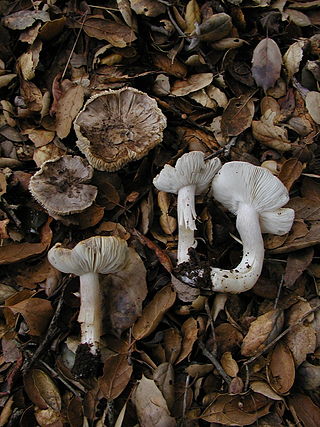
Tricholoma argyraceum is a grey-capped mushroom of the large genus Tricholoma. It has been often confused with the similar-looking Tricholoma scalpturatum.
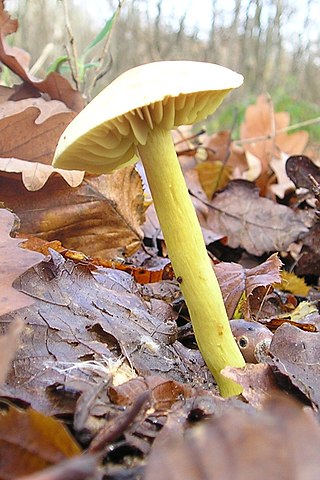
Tricholoma sulphureum, also known as the stinker, sulphur knight or gas agaric, is an inedible or mildly poisonous mushroom found in woodlands in Europe. It has a distinctive bright yellow colour and an unusual smell likened to coal gas. It occurs in deciduous woodlands in Europe from spring to autumn.

Tricholoma magnivelare, commonly known as the matsutake, white matsutake, ponderosa mushroom, pine mushroom, or American matsutake, is a gilled mushroom found East of the Rocky Mountains in North America growing in coniferous woodland. These ectomycorrhizal fungi are typically edible species that exist in a symbiotic relationship with various species of pine, commonly jack pine. They belong to the genus Tricholoma, which includes the closely related East Asian songi or matsutake as well as the Western matsutake and Meso-American matsutake.

Tricholoma pardinum, commonly known as spotted tricholoma, tiger tricholoma, tigertop, leopard knight, or dirty trich, is a gilled mushroom widely distributed across North America, Europe, and parts of Asia. It is generally found in beech woodland in summer and autumn. Two subspecies have been described from southern Europe. First officially described by Christiaan Hendrik Persoon in 1801, T. pardinum has had a confusing taxonomic history that extends over two centuries. In 1762, German naturalist Jacob Christian Schäffer described the species Agaricus tigrinus with an illustration corresponding to what is thought to be T. pardinum, and consequently, the name Tricholoma tigrinum has been used erroneously in some European field guides.

Clitocybe nebularis or Lepista nebularis, commonly known as the clouded agaric, cloudy clitocybe, or cloud funnel, is an abundant gilled fungus which appears both in conifer-dominated forests and broad-leaved woodland in Europe and North America. Appearing in Britain from mid to late autumn, it is edible, but may cause gastrointestinal issues.

Tricholoma terreum, commonly known as the grey knight or dirty tricholoma, is a grey-capped mushroom of the large genus Tricholoma. It is found in coniferous woodlands in Europe, and has also been encountered under introduced pine trees in Australia and New Zealand. It is regarded as edible. A 2014 article speculated that it may be poisonous, but Sitta et al. in 2016 published in the same journal a counter article demonstrating the unfounded nature of such speculation.

Tricholoma saponaceum, also known as the soap-scented toadstool, soapy tricholoma, soapy knight or soap tricholoma is an inedible mushroom found in woodlands in Europe and North America.
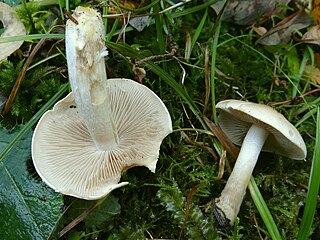
Tricholoma album, commonly known as the white knight, is an all-white mushroom of the large genus Tricholoma. It is found in Europe, India, and possibly North America. The cap and gills are white. The whitish stipe has no ring.

Tricholoma portentosum, commonly known as the charbonnier, streaked tricholoma, or sooty head, in North America, is a grey-capped edible mushroom of the large genus Tricholoma. It is found in woodlands in Europe and North America.
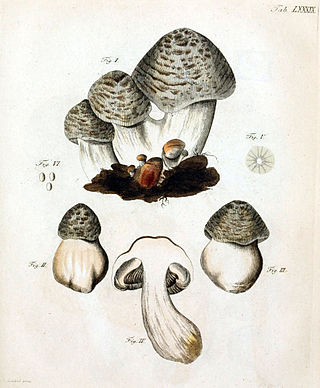
Tricholoma tigrinum is a gilled mushroom. First described under the name Agaricus tigrinus by Jacob Christian Schäffer in 1774, the species was transferred to the genus Tricholoma in 1871 by Paul Kummer.

Tricholoma myomyces is a mushroom of the agaric genus Tricholoma, usually considered to be a synonym of Tricholoma terreum. The species was first described scientifically by Christian Hendrik Persoon in 1794 as Agaricus myomyces, and later transferred to the genus Tricholoma by Danish mycologist Jakob Emanuel Lange in 1933. It is found in Europe and northern North America.

Tricholoma imbricatum is a species of agaric fungus in the family Tricholomataceae. Commonly known as the matt knight, it is found in Europe and North America, where it grows on the ground in coniferous forests. Fruit bodies have a brown to reddish-brown cap, which is often scaly, and ranges from 6–18 cm in diameter, and a stipe that is 3.5–12 cm long by 1–3 cm thick. The gills are initially whitish in color before developing reddish-brown spots. The spores are white.
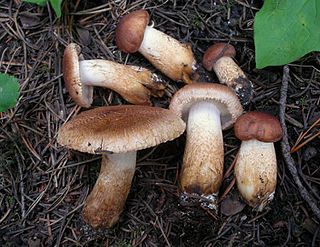
Tricholoma vaccinum, commonly known as the russet scaly tricholoma, the scaly knight, or the fuzztop, is a fungus of the agaric genus Tricholoma. It produces medium-sized fruit bodies (mushrooms) that have a distinctive hairy reddish-brown cap with a shaggy margin when young. The cap, which can reach a diameter of up to 6.5 cm (2.6 in) wide, breaks up into flattened scales in maturity. It has cream-buff to pinkish gills with brown spots. Its fibrous, hollow stipe is white above and reddish brown below, and measures 4 to 7.5 cm long. Although young fruit bodies have a partial veil, it does not leave a ring on the stipe.
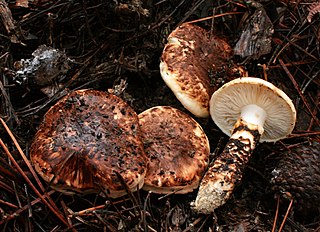
Tricholoma caligatum is a mushroom of the agaric genus Tricholoma. It is a large species with a distinct sheathing ring on the stem, found in mycorrhizal association with various trees throughout the Mediterranean. It is sometimes referred to as the European Matsutake, though it is certainly gastronomically inferior to the true Matsutake, a related species highly prized in Japan.

Tricholoma murrillianum is a gilled mushroom found west of the Rocky Mountains in North America growing in coniferous woodland. This ectomycorrhizal fungus is an edible species that exists in a symbiotic relationship with various species of conifer as well as tan oak and madrone. It belongs to the genus Tricholoma in the matsutake species complex, which includes the closely related East Asian songi or matsutake as well as the American matsutake and Mexican matsutake. T. murrillianum is also known as the ponderosa mushroom, pine mushroom, and Western matsutake.

